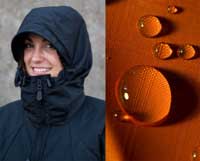By

When Patagonia founder wanted to have a confab about gear, Ernest Capbert knew that he and his cohorts at the outdoor clothing startup were doing something right. The company is the dreamchild of Tom Kay, a British surfer who wanted to create a sustainable clothing line for the action sports industry. Like Patagonia, Finisterre places a major emphasis on how and where it sources materials, creating products with a cradle-to-cradle lifecycle in mind, while fostering a sustainable supply chain. The company is also incorporating biomimicry into its designs while going to great efforts to secure its own source for wool (hint: it takes the do-it-yourself trend to new heights).
The Good Route recently had a confab with Capbert, Finisterre's director of marketing, about the company's clothing line and its focus on sustainability.
Herewith, some outtakes.
The Good Route: How do you go about designing Finisterre clothing and selecting materials?
Capbert: It's always been about sustainable design. We are not using [waterproof] membranes because the process of combining two polymers is really energy-intensive and most fabrics with polymer laminates can't be recycled. Another issue is just how long the products are going to last. The membranes degrade over time. A jacket might last three to four years [before losing waterproofness]–that's not long-lasting enough for us.
The Good Route: Finisterre has been recognized for its efforts in using biomimicry–using otter fur as a template. Where is that showing up in your products?
Capbert: A lot of what nature does is awe-inspiring. So we try to use it in the way we make clothing. After lots of research with academics at Bath University, we have been able to manufacture the Napa lining. It mimics the structure of otter fur. The lining has multiple layers that work to keep heat close to the body while wicking away moisture and its used in the latest versions of our Humboldt and Storm Tracker jackets.
The Good Route: And you're starting up a new effort to source the wool used in your base layers?
Capbert: We source our Merino wool in Tasmania, from a group that gives accreditations for ethical Merino sheep farms. But we found out that the group is not just the accreditation organization but also an exporting company. There sheep in Tasmania that are exported when they get old. We are against live export. Plus, interest in Merino is spiking and because of this, companies [farms] are going to try to fill demand and things will fall through the cracks.
There are free trade groups, ISO certifications, etc. Standards are good, but not good enough. This whole thing showed that if you want to go anything you have to do it yourself. We don't have enough visibility into the supply chain. So we started the Natural Advantage program. Merino sheep are not robust enough for the climate in England and Scotland, but about 30 years ago a new breed of sheep was started that is a combination of Shetland and Saxon Merino. The goal was to create sheep with soft, fine wool like Merino but in an animal that could stand the climate here. But soon after this new breed, call Bowmount, was made, the the US wool market fell out and the project was given up. The Bowmont flocks that had been bred were sold and many were slaughtered or crossbred with Shetlands. So we are working with a breeder here and are looking for and breeding more Bowmount. We have 35 so far and we need 95 to start getting enough wool to manufacture with it.
—is a freelance writer, covering the environment, sustainability andoutdoor recreation. The Good Route, her new blog for �����ԹϺ��� Online, isfocused on the places where the active life and sustainability merge.